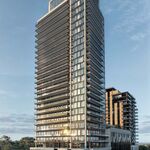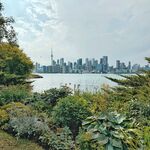These neighborhoods of single family homes are dependent on cars to do everything -- groceries, shopping, commuting. If we want to dent car dependency, we need to make it easier to make these local trips without one. That means making it easy to get to the store nearby instead making it easy to get to Yonge or Malvern. The LRT, at least, was a good compromise on locality and speed -- throwing down a surface stop has a cost of virtually nothing while still letting you get to Malvern reasonably fast. If you have options for travelling locally (bike/walk/transit) then not only is it less likely you need to travel far to begin with, when you do need to travel, it's easier because the roads aren't clogged with people doing local trips.
Whereas you spend $300MM+/km to tunnel through suburbia without the 20,000pphpd to justify it.
Using LRTs to get people to get out of their cars for local traffic is impractical in low density environments. In a car you can carry a massive amount of groceries and items, all while taking only 5 minutes to get to your destination. If you want to do grocery shopping with local transit, first you have to spend 10 minutes getting to the LRT, then wait around 5 minutes for the next train, all to ride maybe 1 stop. You're not going to get anyone out of their car with that.
The reality of LRTs is that they are fantastic as local transit - in high density environments where people live and work right next to the LRT. With the way Toronto suburbs are designed, LRTs absolutely fail at being adequate local transit - any transit on a Toronto Arterial can only function as a funnel to another subway line. This is why if we look at what regions in the 905 are doing - they're building BRTs with wide stop spacing that serve as longer distance commuting options - NEVER TO ACT AS LOCAL TRANSIT.
"The LRT, at least, was a good compromise on locality and speed"
Full Stop: They are a good compromise on locality and capacity, LRTs are a disaster when it comes to speed. If you want speed, you build BRTs for their low cost, or Light Metros - end of story.
On the surface, LRTs in low density suburbs make sense, and I could understand why at a high level view they sound appealing: They are lower capacity than regular metros whilst being relatively cheap: Perfect for the amount of traffic one might expect on a suburban arterial. The reality however is that LRTs absolutely fail at providing suburbanites actually useful transit when you consider their needs: The average suburbanite travels up to 10km on their weekday commutes to reach their destinations: LRTs with tight stop spacing that Toronto wanted to build with Transit City and that you're advocating for absolutely fails at this. By being slow, the LRTs become extremely unattractive as a mode of transit for general purpose use, and as such are bad at getting people out of their cars.
I've used this example a million times, but I'll reiterate it again: Compare Portland's transit system with Vancouver's transit system - 2 cities with very similar populations and similar polycentric designs. Portland built a massive LRT network - prioritizing quantity over quality, meanwhile Vancouver built massive high speed elevated metro lines into its suburbs that are fed by frequent bus services - prioritizing quality over quantity. Despite having far less kilometers of rail, Vancouver has a ridership that is 5x higher than that of Portland's. Its so bad in fact that in the worst months of COVID, Vancouver's transit ridership was still higher than what Portland had pre COVID.






